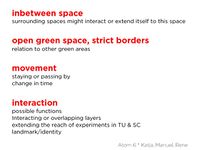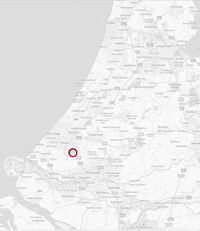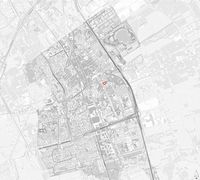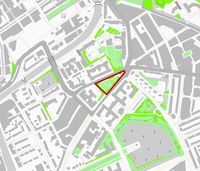From student
(Difference between revisions)
|
|
| Line 9: |
Line 9: |
| | ;[[User:Manuel|Manuel]]: | | ;[[User:Manuel|Manuel]]: |
| | | | |
| − | </div>
| |
| | | | |
| | + | [[atom06:ABOUT hyperbody| |
| | + | '''ABOUT hyperbody''' |
| | + | ]] |
| | | | |
| − | =ABOUT hyperbody=
| + | </div> |
| − | | + | |
| − | In '''Architecture goes wild''', '''Kas Oosterhuis''' says that:
| + | |
| − | "Architectural bodies are the target of technological invasion. They take part in global networks, they are connected. They interact with databases [people, websites, buildings, tables] in realtime and their shape and content changes all the time. Architecture no longer has a static end-configuration. The visible appearance of any building will become as unpredictable as the weather."
| + | |
| − | {|
| + | |
| − | | [[Image:Archspace architecture gone wild kas oosterhuis 1.jpg|thumb|200px| ]]|| [[Image:Archspace architecture gone wild kas oosterhuis 2.jpg|thumb|200px| ]]||[[Image:Archspace architecture gone wild kas oosterhuis 3.jpg|thumb|200px| ]]||[[Image:Archspace architecture gone wild kas oosterhuis 4.jpg|thumb|200px| ]]
| + | |
| − | |}
| + | |
| − | [http://www.arcspace.com/books/Oosterhuis_2/oosterhuis2_book.html '''Architecture goes wild''' by '''Kas Oosterhuis''']
| + | |
| − | | + | |
| − | | + | |
| − | The way to get there:
| + | |
| − | "Every design that architects create is a hypothesis, which can only be proven once the building is built. For immediate validation of design hypotheses, instead of constructing representations of to-be reality, we have to create architectural systems through experiential prototyping in physical and virtual space. Such prototypes are fully operational from day-1 of the design process. In this way the distinction between design and inhabitation of architecture blurs. In such process we take advantage of the principles of non-standard architecture and its special case - interactive architecture." - [https://docs.google.com/document/d/1lFgtQAKb5G9a-IpDLaMgYuaOi3WsSfrJnl4y002ys1U/edit?hl=en_US design studio brief]
| + | |
| − | | + | |
| − | '''The idea is to make a non-standard architecture, a place that reacts, that breathes and ''inter''acts to and with the people that use it.'''
| + | |
| − | '''Using software to make it possible to map analyses to help design the building in an optimal way regarding sun or people movement, or any other variable. Creating shapes with often a complex theoretical computational background to make futuristic designs that stimulate us.'''
| + | |
| − | | + | |
| − | | + | |
| − | | + | |
| − | some architects holding to these ideas are:
| + | |
| − | | + | |
| − | [http://www.panarchitects.com pan architects]
| + | |
| − | | + | |
| − | [http://www.su11.com architecture + design]
| + | |
| | | | |
| − | [http://www.oosterhuis.nl/quickstart/index.php ONL Oosterhuis & Lénárd]
| |
| | | | |
| | =ABOUT the project: intent and challenges= | | =ABOUT the project: intent and challenges= |
Revision as of 07:40, 19 September 2011
Atom 6
ABOUT the project: intent and challenges
The location is de Vries van Heystplantsoen in Delft. Here are historical maps from 1915 and pictures of the site from 1925 and 1926 for a feel of area site history
Before going to the site to explore it, we tried to come up with what (site) aspects we wanted to look at, and how we were planning on doing that.
The site is currently a park
The challenges
"In our own design work – the ‘context’ is a main centre of effort. It is not exactly a question of ‘fitting- in’, but of re-materialising, re-focusing – the words are difficult. The context may demand a totally invisible building or no building, a ‘countergeometry’ or a ‘continuation geometry’. In a way like decorating, re-arranging and ‘preparing’ a room, for a real homemaker, a real restaurateur or inn-keeper it is more than a question of taste: it is an act of both continuity and re-generation." Peter Smithson
To allow two systems to interact actively, in a sort of continuous exchange of information, knowledge and feelings in order to reactivate the potential network of the city.
The Problems:
- no relation between site and context
- no attractive elements
- a lot of traffic around
The Opportunities:
- becoming a bridge between city and TU/TNO
- new place to show scientific results
- becoming a new meeting point
- to extend the botanical gardens
- becoming a new landmark for the north entrance of the TU
The How:
creating a public platform, a topological surface continuously molded, bent and deformed by the actions of the elements that compose the surface.
In this space there's no distinction between object and context but are privileged interconnections.
ABOUT our work
on these pages we will explain the what and why of what we do, from our analyses to our concept to our final design
Work overview



